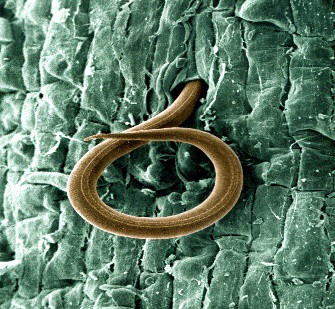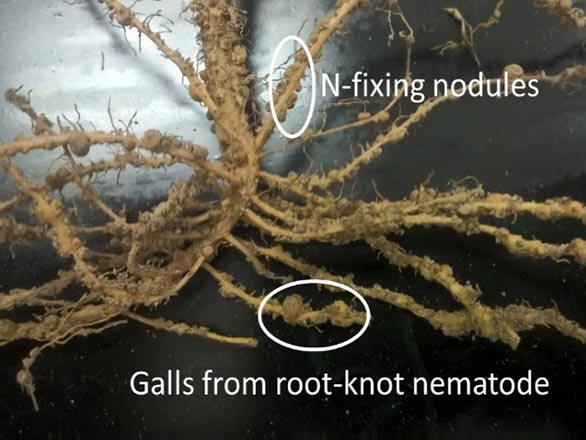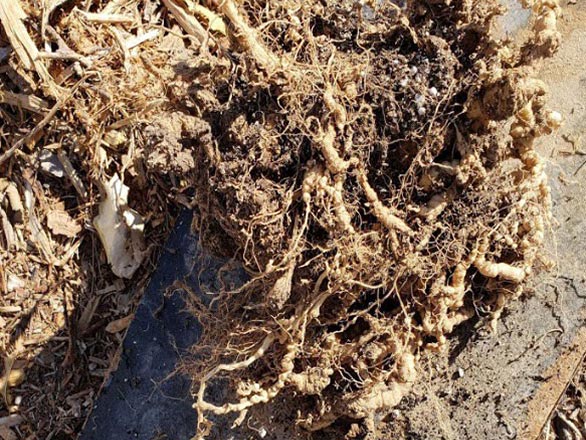Introduction
When a plant in the landscape grows poorly or dies, gardeners need to discover the cause. Among the questions they must ask include:
- Was the plant adapted to the environment?
- Was it planted properly?
- Was there any damage to the plant from tools?
- Did the irrigation fail?
- Did a rabbit or another four-legged pest eat it?
- Have insects been chewing, sucking or eating the leaves, or attacking stems?
- Did the plant develop a disease? On what plant part?
- Did a neighbor or the gardener apply an herbicide (weedkiller), which might have drifted to a nontarget plant?
Any of these aboveground reasons can cause a plant to fail. When none of the usual explanations works, then the gardener must explore further – underground.
Some belowground pests are easy to see, ground squirrels and certain insects for instance, but others are only visible under a microscope. While these pests might not be easy to see, their effects on plants can be obvious.
 What’s a nematode?
What’s a nematode?
Nematodes are microscopic worms (also called eelworms or roundworms) distantly related to insects and spiders. With more than 15,000 species, they are among the most plentiful animals on earth. There can be nearly 60,000 nematodes in a square foot of soil.
Many are parasites on animals, but about one- tenth are parasites on plant hosts. They are responsible for anywhere from 5% to 15% of all plant losses worldwide, a value of about $157 billion.
Other soil-inhabiting nematodes that do not prey on plants may eat bacteria, fungi or other nematodes, and may be important for breaking down organic matter in the soil.
While they require soil to have a film of moisture in order to move, they will die from lack of oxygen if the soil is totally saturated. They are also unable to tolerate very dry soils.
Temperature variation can likewise affect them; very high or freezing temperatures can even be fatal to nematodes.
In the soil, nematodes are slow moving, perhaps traveling less than four feet in a season, but soil disturbance and moving plants around may spread them widely. Nematodes are generally in the top foot of soil, but depending on the species and the environment, they may be as deep as several meters.
What’s a root-knot nematode?
Among the most devastating of underground pests is the root-knot nematode (Meloidogyne spp.).
As the name suggests, this organism is a parasite on and in plant roots. Infected roots have galls, causing them to look as if they have been knotted (hence the name). This pest has a very wide “host range” and can attack tomatoes, peppers, carrots, onions, cactuses, roses, fruit trees and many ornamentals.
 Recognizing the problem
Recognizing the problem
How do root-knot nematodes arrive in a garden?
Nematodes can spread through soil, tools, rainwater, footwear and machinery. Since they are most active in warmer weather, the problem might not appear until late spring, when the damage has been done and becomes apparent.
When purchasing new plants, make sure to examine the roots before buying. If the roots look knotted and deformed, do not accept the plant.
How do I know if the problem is root-knot nematodes?
Many indicators arise from a root-knot nematode infestation, but some of them may be confused with other problems. Short of removing a plant entirely, it is a good idea to track the symptoms. The following are symptoms of nematode infection, with other possible sources.
 Above-ground symptoms may be confused with other environmental or root problems. Above ground, the plant may show some or all of the following before dying:
Above-ground symptoms may be confused with other environmental or root problems. Above ground, the plant may show some or all of the following before dying:
a. Stunting – the plant does not develop normally. It is prevented from growing, it is smaller and experiences a loss of vigor. This can be due not only to root-knot nematode, but also to viruses, other microscopic organisms, or even a nutrient deficiency.
b. Chlorosis – the leaves look pale, even yellowish. In addition to root-knot nematode, this is often due to nitrogen deficiency, herbicide damage, or poor soil drainage.
c. Mid-day wilting – as temperatures increase over the course of a day, the plant requires increased water. When nematodes colonize roots, much of the root system is unable to obtain soil water.
d. Leaf drop – with damaged roots, the plant is unable to acquire enough water. One survival method is to drop its leaves, which lose water. However, in addition to nematodes and drought, another cause of untimely leaf drop is a deficiency of the element zinc. This micronutrient is necessary for the leaf to remain securely attached to the plant.
e. Small fruit and reduced yield – since the plant is unable to obtain sufficient water and nutrients (barely enough to keep it alive), it can only divert a minimum of resources to developing fruit. With some kinds of plants (e.g. lettuce), there is a decrease in the number of healthy harvestable plants. For other plants, there may be patches of poor growth, indicating the loss of healthy root tissue. Another cause of this problem may be that too many small fruits were left developing on a tree.
Look for:
- “Dirty roots” (dark brown, soft, even slimy) This indicates that the roots are rotting. Healthy roots are usually cream colored and succulent.
- Stubby, stunted roots.
- Dark patches on the roots.
- Galls & swellings.
What makes root knot nematode such a problem?
In addition to their enormous host range, nematodes have many characteristics that cause them to be difficult to control.
- They are among the few animals that can reproduce without any contribution from males, although there are male root-knot nematodes.
- They counteract host plant defenses, so the plant is less able to deal with them. Compounds that they produce can modify plant cell walls, which permit the nematode to enter the root.
- In order to maximize the amount of tissue the pests can invade, they may alter the activities of plant hormones and mimic other important plant molecules.
- Nematodes can minimize plant resistance by regulating the plant’s response to stress. • Infection by root knot nematode may interfere with nitrogen fixation in legumes, such as beans, peas, mesquite, and cassia, among others.
- A female root knot nematode may produce 1000 eggs. After the female enters a plant root, she can cause physiological changes in the plant for her own benefit. She injects compounds that cause some plant cells to become “giant cells”. The plant then produces large amounts of important molecules such as hormones, proteins and other compounds that nourish her and her offspring, at the expense of the host plant.
- The roots become infected with galls of various sizes. These growths interfere with water and nutrient movement in roots. As a result, the plant suffers from lack of water and essential nutrition.
- Root-knot nematodes may also cause their host plants to be more prone to infection by other pathogens, causing further plant problems.
Preventing infestation is not an easy task.
- Try to use plants that are certified as nematode-resistant. Even if there are no susceptible plants in the soil, root-knot nematodes can feed on weed roots, so keep gardens weed free.
- Some plants are more susceptible to root-knot nematodes than others. Rotate plant families. some plants, like carrots, may become strongly infected, so avoid planting carrots or parsnips in the same area for several years.
- There are even several varietal differences. For instance, ‘celebrity’ tomatoes are resistant to root knot nematode, but ‘Early Girl’ tomatoes are highly susceptible. Growing resistant varieties results in higher yields and a decreased nematode population.
- Add compost to the soil. This can be a source of beneficial fungi, bacteria and predatory nematodes, which will provide a level of control of the pest. It also helps to keep soil evenly moist, which prevents drought stress to susceptible plants.
- Keep tools clean, especially anything used to dig in the soil. It is easy to cross- contaminate soil with these microscopic animals.
- When planting, look for the initials V-F-N on the plant tag or the seed package. The V and F stand for resistance to two soil borne fungi that cause plants to wilt; the N means that the plant or seeds are resistant to nematode infection.
- Use of predatory beneficial nematodes can also help control harmful ones.
Treating (No conventional commercial nematicides are available for home use.)
When soil is already infected with root-knot nematodes, there is no quick remedy. Be certain to discard infected plants; do not compost them, as temperatures may not kill all the pests.
University of California Cooperative Extension recommends several actions:
- Plant cool season crops (planted in early spring and fall) when soil temperatures are below 64° F. Plant warm season crops as early as possible so plants may become established before nematodes become active as temperatures rise.
- Leave the soil fallow (unplanted) for three growing seasons.
- Solarize planting beds, using clear plastic sheeting to create a solar oven. This requires taking that area out of production for up to two months, but it virtually sterilizes the soil, killing microbes, weeds and nematodes.
- Plant a susceptible crop to capture some nematodes. These would need to be removed quickly.
- Some organic products are on the market. These tend to be costly, but may be effective.
- Certain bacteria and fungi, particularly mycorrhizal fungi, have been effective in suppressing the population of nematodes.
Conclusions
Root-knot nematodes are very difficult to control or manage, since they live below ground and their symptoms may be confused with other plant problems. For a home gardener, they can be daunting, but not an impossible challenge.
Recommendations:
- First, whenever possible, select resistant varieties.
- Second, add compost to the planting mix, which will introduce beneficial microorganisms and improve both soil water holding and drainage.
- Third, be aware that symptoms of root knot nematode damage may be similar to problems from other causes, such as other pests or nutrient deficiency.
- Fourth, healthy plants are more resistant to pests than stressed ones. Maintain adequate moisture and fertilizer.
- Fifth, follow recommendations for planting times, keeping in mind that root knot nematode are more active at higher temperatures.
- Sixth, solarize soil when there has been a problem.
O’Callaghan, A., Robinson, M.L., and Haas, S.
2020,
Root-Knot Nematode,
Extension, University of Nevada, Reno, FS-20-24


